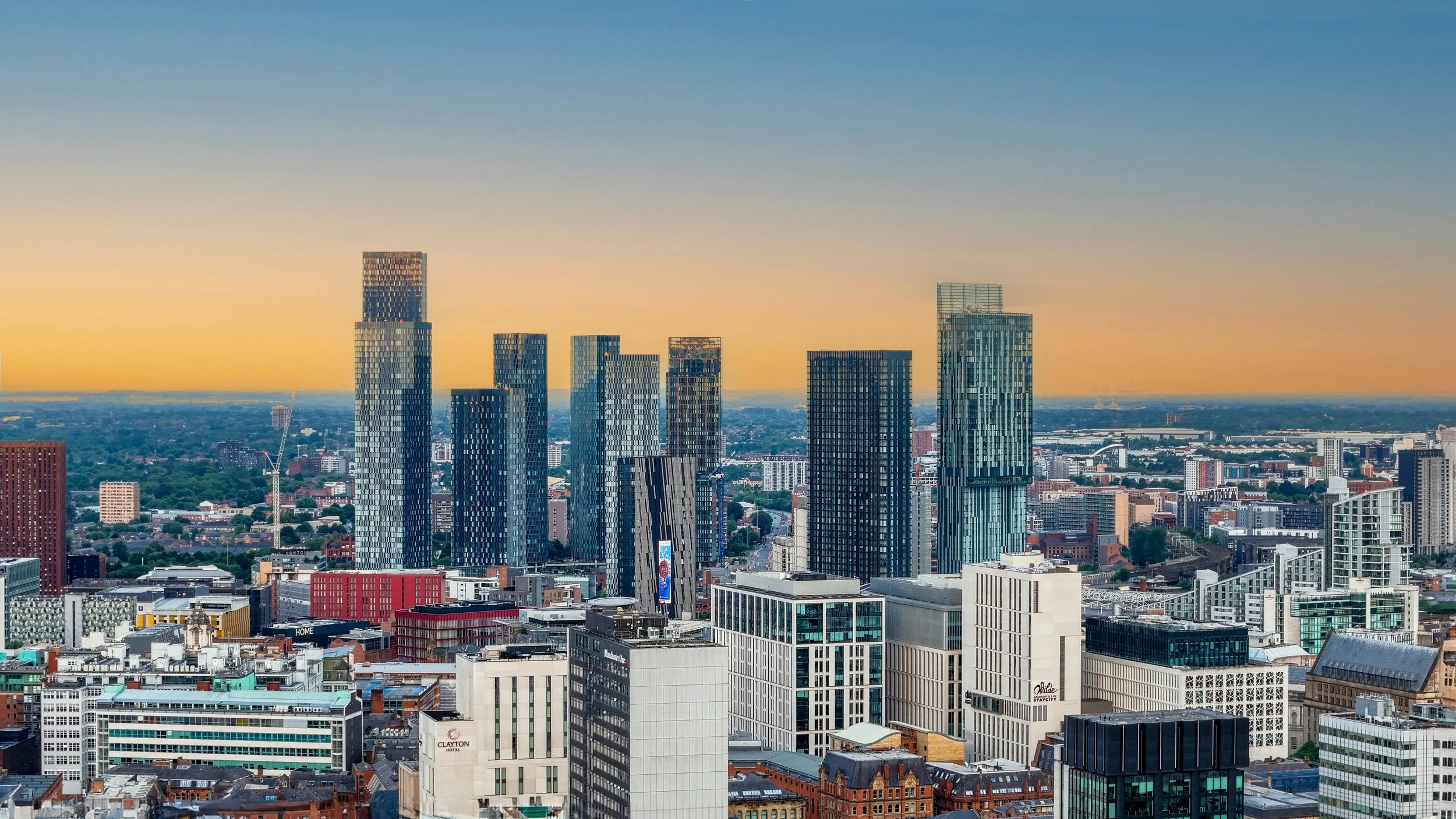How to buy commercial property
Commercial property typically provides higher returns than UK residential property, yielding 6.5% compared to 4.1%. It can therefore be a profitable and also stable investment, whether you’re an investor looking to secure tenants, or a prospective owner-occupier planning to run your own business from your new premises.
However, while returns may be attractive, commercial properties usually cost more to buy than residential properties, and they can be more sensitive to market conditions. This is why it’s so important to conduct thorough research so you can understand the potential risks as well as the promise of a property, taking into account vital factors like location, tenant demand, tax implications, property condition and funding options.
If you’re new to commercial property investment this may sound like a lot to get your head around, but an experienced property consultancy can make this whole process much easier. And we hope this guide, too, will make the idea of buying commercial property much less daunting and explain every step you need to take.
Buy a commercial property that suits your business needs - uses and classifications
There are of course many different types of commercial properties and you need to consider existing uses when looking at what’s on the market and what might suit your needs. The main categories are:
Office spaces - Traditional office buildings, flexible co-working spaces and business parks.
Industrial properties - Warehouses, distribution centres, factories, and workshops.
Retail properties - High street shops, shopping centers, retail parks and standalone stores.
Leisure properties - Hotels, restaurants, pubs, gyms, cinemas, and entertainment venues.
Healthcare properties - Medical centres, GP surgeries, dental practices, care homes and specialist healthcare facilities.
Commercial property use classifications
As well as these general categories, commercial properties have official use classifications. Historically they were categorised by the Town and County Planning Use Classes Order 1987, but in September 2020 there was a reform and new classes (E, F.1 and F.2) were added to the existing classes (A-D).
Commercial property use classes use letters for each class and its subcategories, then numbers for the breakdown of a subcategory. This helps you clearly show your intentions if you apply for planning permission or change of use.
|
A1 - Shops |
C1 - Hotels |
|
A2 - Financial and professional services |
C2 - Residential institutions |
|
A3 - Restaurants and cafés |
C2A - Secure residential institutions |
|
A4 - Drinking establishments |
C3 - Homes |
|
A5 - Takeaways |
C4 - Houses in multiple occupation |
|
B1 - Business |
D1 - Non-residential institutions |
|
B2 - Industrial |
D2 - Entertainment and leisure |
|
B8 - Storage or distribution |
The new classes
E
|
Ea - Display or retail sale of goods, other than hot food |
|
Eb - Sale of food and drink principally to visiting members of the public where consumption of that food and drink is mostly undertaken on the premises |
|
Ec - services principally to visiting members of the public
|
|
Ed - Indoor sport, recreation, or fitness, not involving motorised vehicles or firearms |
|
Ee - Provision of medical or health services, except the use of premises attached to the residence of the consultant or practitioner |
|
Ef - Crèche, day nursery or day centre, not including a residential use |
|
Eg - Uses that can be carried out in a residential area without detriment to its amenity:
|
F.1
|
F1a - Provision of education
|
|
F1b - Display of works of art (other than for sale or hire)
|
|
F1c - Museums |
|
F1d - Public libraries or public reading rooms
|
|
F1e - Public halls or exhibition halls |
|
F1f - Public worship or religious instruction (or in connection with such use) |
|
F1g - Law courts |
F.2
|
F2a - Shops (mostly) selling essential goods, including food, where the shop’s premises don’t exceed 280 square metres and there is no other such facility within 1000 metres |
|
F2b - Halls or meeting places for the principal use of the local community |
|
F2c - Areas or places for outdoor sport or recreation (not involving motorised vehicles or firearms) |
|
F2d - Indoor or outdoor swimming pools or skating rinks |
Sui Generis (in a class of its own)
These are specifically defined and excluded from classification by legislation and include:
|
Theatres |
Casinos |
|
Amusement arcades/centres or funfairs |
Betting offices/shops |
|
Launderettes |
Bay day loan shops |
|
Fuel stations |
Public houses, wine bars, or drinking establishments |
|
Hiring, selling and/or displaying motor vehicles |
Drinking establishments with expanded food provision |
|
Taxi businesses |
Hot food takeaways (for the sale of hot food where consumption of that food is mostly undertaken off the premises) |
|
Scrap yards, yards for the storage/distribution of minerals and/or the breaking of motor vehicles |
Venues for live music performance |
|
‘Alkali work’ - work registerable under the Alkali, etc. Works Regulation Act 1906 (as amended) |
Cinemas |
|
Hostels (providing no significant element of care) |
Concert halls |
|
Waste disposal installations for the incineration, chemical treatment, or landfill of hazardous waste |
Bingo halls |
| Retail warehouse clubs |
Dance halls |
| Nightclubs |
It’s worth noting that changing the use of a commercial space might not always require planning permission if the use sits within the same class as before. However, you should always make sure to check this before you start making any changes.
Weighing up the costs of buying a commercial property
There are various costs associated with acquiring (and keeping) a commercial property that you need to be aware of. To make these as clear as possible, let's split them up into three sections, covering the purchase itself, moving-in expenses, and the cost of maintenance.
The cost of buying a commercial property
Deposit - A deposit is typically required at the point when contracts are exchanged, the remainder to be paid when the deal completes.
Advice - The vast majority of buyers - whether you’re new to buying commercial property or not - need help from a lender, a solicitor and a commercial estate agent.
Stamp Duty Land Tax (SDLT) - If you buy a commercial property valued over £150,000 you’re liable to pay this tax. The rate is 2% for a sale price up to £250,000 - above that the rate is 5%. NB - SDLT has been replaced with Land Transaction Tax in Wales, and the Land and Buildings Transaction Tax in Scotland.
VAT - Generally speaking, VAT doesn’t apply to commercial property sales or the rent, and it’s exempt unless the seller or landlord opt to charge VAT. In which case the rules around VAT for commercial property are fairly complex, so professional advice is important to understand your specific situation.
Capital gains tax - it’s worth noting that the interest on commercial mortgages is tax-deductible and this is a way to potentially save on capital gains tax, but it still needs budgeting for.
Commercial mortgage fees.
The cost of moving into a commercial property
Refurbing and decorating - Can be a significant cost so must be considered in your budget.
Fitting out the space - Making the property meet your business needs and installing furniture and equipment.
Removals costs - The cost of hiring a company to transport furniture and equipment.
Setting up equipment and facilities - Setting up your vital equipment and establishing IT and other key facilities.
The cost of maintaining a commercial property
Insurance
Repairs and maintenance
Services - May include cleaning and security.
Local authority charges - Such as waste collection.
Commercial property management - Retaining a property agent to manage your building.
Commercial mortgage repayments
Business rates - They are worked out by multiplying the rateable value of the commercial property, as set by the Valuation Office Agency (VOA), by the Uniform Business Rate (UBR).
Energy costs - The vendor will give you an Energy Performance Certificate (EPC) to indicate how energy-efficient the property is and roughly what your bills will be.
How to fund your commercial property purchase
Cash purchase - If you have enough capital you could buy with cash, which avoids interest costs and potentially gives you a better negotiating position.
Commercial mortgages - Similar to residential mortgages, however, they often require larger deposits (25-40% of property value), with shorter terms (15-25 years).
Bridging loans - A bridging loan is a short-term financing option to cover the gap between purchasing a property and securing longer-term funding, or when quick completion is required. These loans often have higher interest rates than other options mentioned here.
Auction finance - Specialised short-term loans to help if you’re buying a property at auction (completion is usually required within 28 days).
Pension funds - Self-Invested Personal Pensions (SIPPs) can fund commercial property purchases and provide tax advantages.
8 steps to buying a commercial property
So, how exactly do you go about acquiring a commercial property? Let’s go through the steps one at a time to take the mystery out of the process.
Once you have decided on the right property for your business, you take the following steps, usually with the help of a solicitor, estate agent and ideally a property consultant/chartered surveyor to ensure due diligence throughout:
Purchase price agreed - You come to an agreement on price with the seller, usually via an estate agent. Then the estate agent prepares a memorandum of sale, setting out the key points of the transaction. This isn’t legally binding but needs to be accurate because it is referred to for legal drafting.
Solicitors instructed - After both parties agree on the Heads of Terms, documents are sent to each party’s solicitor. Your solicitor may ask for money on account for property searches and land registry documents.
Contract package sent - The seller’s solicitor sends this to your solicitor. It typically includes a draft sale document, title documents, replies to Commercial Property Standard Enquiries (CPSEs) and an Energy Performance Certificate (EPC).
Buyer’s due diligence – Your solicitor carries out due diligence checks on the property.
Review of mortgage papers – Your solicitor reviews the terms of the mortgage and other security documentation provided by the lender and must respond to any lender’s requirements.
Contract agreed and reporting – Once your solicitor has done their due diligence, they negotiate the terms of the sale contract and transfer deed with the seller’s solicitor.
Contracts exchanged – Once you and the seller have signed the sale documents, your contracts are exchanged and your solicitor sends your deposit.
Completion – Your solicitor receives the funding from your lender and sends the remaining balance to the seller’s solicitor. The transfer deed and mortgage are completed and the legal title passes to you.
Ready to buy a commercial property?
Buying commercial property clearly has its complexities, but that doesn’t mean it has to be difficult. We at The UpCo are here to help you begin or continue your investment journey, from research right through to completion. Every day we help private and corporate clients find the perfect property and we’d love to help you.
Get in touch today to discuss your situation and your goals - email us at hello@theupco.co.uk or call 0151 542 5000.



